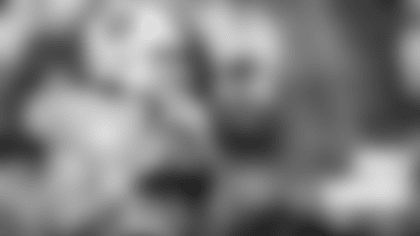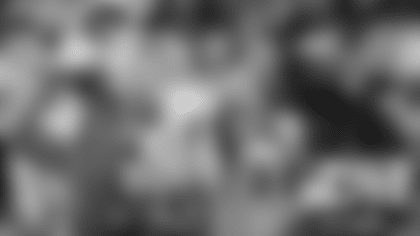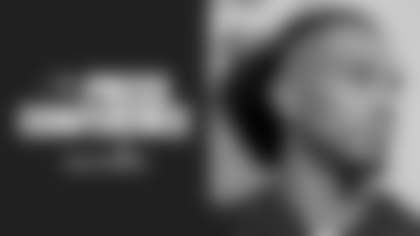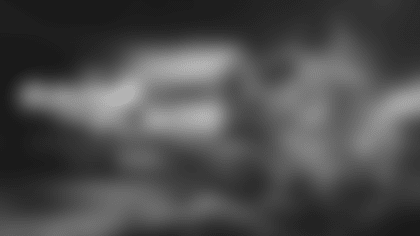- Comparing depth chart positions across the NFC South, can anyone compete with the Saints' Pro Bowl guards?
- As good as Lavonte David is, the Panthers likely take the division crown for the top overall LB crew
- Where do the Buccaneers and Falcons top the list in a comparison of positions?
Back in March, just as the Tampa Bay Buccaneers were wrapping up their intense first week on the free agent market, NFL.com media columnist Adam Schein took a look at the NFC South and saw it shaping up as "the most fun and most competitive" division in the NFL in 2014.
You'll get no argument here, but please permit me this small, four-months-delayed reaction: "What else is new?"
Now, there's no doubt that the most competitive (and dominant) division in the league last year was the NFC West. The AFC West actually produced the most playoff teams, with three, but the NFC West's third-place squad, Arizona, finished a game better than Wild Card qualifier San Diego in the overall standings. Both of those divisions sent a team to the Super Bowl, but top to bottom, the NFC West was stronger. Who would you rather your team played last year (or this year), NFCW fourth-place squad St. Louis or AFCW fourth-place club Oakland?
Using a more historical perspective, however, there's no doubt that the NFC South has been the most consistently competitive and unpredictable of the eight divisions that were the product of realignment in 2002. It is an oft-repeated but no less telling note that in a dozen years of existence the NFC South has never had a repeat champion. Moreover, each team has won exactly three division titles so far.
None of the other divisions has seen their champions distributed so evenly, and in fact four of the other seven divisions still have one participant looking for its first crown. Every other division has had repeat champions; in fact, every other division except the AFC North has had a team win at least three titles in a row. The NFC South is also the only division that has sent all four of its teams to the conference championship game since realignment. Only the AFC East has more combined conference championship game appearances than the Bucs' division, and that's almost exclusively due to the Patriots' ongoing dominance.
Back to Schein. His essential point is that the NFC South is too tight to call right now, given that, in his estimation, "the downside for each team appears to be eight wins." Schein notes that three of the four teams in the South made well-received roster updates while the fourth, Carolina, is the defending champion. The Panthers and Saints were playoff teams last year, while the Falcons were decimated by injuries and the Buccaneers had a sneakily-talented core that has since been significantly augmented. One can certainly foresee these four teams converging in the standings in 2014, making every game on the schedule (especially the intra-division ones) critically important and, as Schein notes, extremely entertaining.
Still, even within the most competitive divisions, there are inequalities. On paper, at least, the Panthers seem to be lagging behind the other three teams at the receiver position. The Buccaneers and Panthers both have some undecided spots on the offensive line. The Falcons have had trouble in their secondary in recent seasons. The Saints didn't run the ball all that well last year and subsequently lost Darren Sproles.
That's what we're here to examine today, but from a more positive point of view: At what position on the depth chart does each team in the NFC South clearly outshine its three division foes?
Two quick notes before we go team by team:
- I decided right off the bat not to consider the quarterback position among my choices. I really don't want to argue the relative merits of Drew Brees, Matt Ryan and Cam Newton, or whether Josh McCown belongs in that group. I will say that I consider Brees to be the best of that bunch (such a controversial stand!) but that position really could be a major strength for all four teams. Plus, if things go as each team intends, the QB backups won't see much action, so we're only comparing one guy on each squad.
- The hardest team to nail down in this exercise was the Buccaneers, as you'll see below. That's not all bad – there were a lot of positions on the Bucs' depth chart that merited consideration, but they usually matched up against at least one other strong unit in the division. Still, overall I would say this is a byproduct of Tampa Bay having very promising but unproven situations in many corners of the depth chart.
Now, let's take this alphabetically:
1. Atlanta Falcons: Wide Receiver
When healthy, Julio Jones and Roddy White might be the most dangerous starting wide receiver duo in the NFL, though McCown's old teammates in Chicago, Brandon Marshall and Alshon Jeffrey, would have a strong argument. Jones and White were not healthy for much of 2013 (especially Jones) but they should be back to terrorize NFC South cornerbacks again this fall. Atlanta also has a very nice third receiver in Harry Douglas, who took advantage of the playing time offered by Jones' absence last year in a big way. Douglas led the Falcons with 85 catches for 1,067 yards, more than double anything he had done in the past. His presence gives Atlanta a way to ride through any short-term absences by the starters and, more to the point, makes the Falcons' three-receiver set quite potent. Atlanta isn't particularly deep at receiver after that – Courtney Roby is the next most experienced wideout on the roster unless you count Devin Hester – but who in the division is?
It's possible that the Buccaneers will close the gap on the Falcons in this department by season's end. If Mike Evans, the seventh overall pick in the draft, makes an instant impact, he and Vincent Jackson could be one of the best starting pairs in the league, as well. Evans has to prove that first, of course, and the Buccaneers are even more unsettled behind their front-line pass-catchers than are the Falcons. As mentioned, the Panthers' receiving corps is completely unsettled after the departures of Steve Smith and Brandon LaFell, with raw first-round pick Kelvin Benjamin joining a group of middling veteran signees (Jason Avant, Jerricho Cotchery, Tiquan Underwood, etc.). And while the Saints' passing attack is always dangerous, that's more attributable to Brees and a stout line in front of him. Marques Colston is still the leader of that group and rookie Brandin Cooks is very intriguing, but the Saints don't have a top three to match the Falcons. We're talking just "wide receivers" here, and Jimmy Graham (85 catches) is apparently not one of those. Neither are Pierre Thomas (77 catches) or the departed Sproles (71).
Other positions considered: The Falcons had to do a lot of offensive line juggling last year (seemed to be a divisional theme) but they might rise out of that with a very strong pair of offensive tackle bookends. Sam Baker returns from a season in which he missed 12 games and will either step back in at left tackle or slide to the right side to accommodate Jake Matthews, the sixth-overall pick. I'm not sure, however, that's a sure enough thing to choose that duo over the Bucs' Anthony Collins-Demar Dotson pair. I didn't really consider kickers or punters in this exercise, but if I had it would be hard to top the two Matts, Bosher and Bryant, who have formed one of the league's most dependable kicking duos over the past three years. And if I was including the quarterback position, Matt Ryan might even qualify as "underrated" at this point after an unappreciated performance in very tough situation last year.
2. Carolina Panthers: Linebacker
If I hadn't originally confined this exercise to a single position, I might say "front seven" instead in order to be more inclusive. The Panthers have a pair of sack-happy ends in Charles Johnson and Greg Hardy and their rookie defensive tackles (Star Lotulelei and Kawann Short) seemed to complete the picture last year. However, it's at linebacker where they stand head and shoulders above.
Like the Buccaneers with Lavonte David, the Panthers found a superstar linebacker to build around in the 2012 draft. Both David and Kuechly were first-team Associated Press All-Pro selections last year and are likely to become regulars on that list. It's your choice as to which flavor you like the best out of that duo, but Kuechly was part of a more dominant linebacker unit overall in 2013. Expect more of the same in 2014. Also back is Thomas Davis, who had a huge year last year as well on the league's second-ranked defense, combining 123 tackles with four sacks, two interceptions and seven passes defensed. Chase Blackburn, a dependable veteran who came over from the New York Giants last year, could step right back in as the other starting outside linebacker, or that could go to developing second-year man A.J. Klein, who had two sacks last year.
Again, this is another spot at which the Buccaneers might be closer to the top of the list at the end of the season. David is brilliant, and Mason Foster could give him a Thomas Davis-level partner if he thrives in the Bucs' new Cover Two defensive scheme. Alternately, free agent acquisition Nate Fletcher could succeed in his quest to win the starting MIKE job and prove that the flashes he showed in snippets of playing time in New England can translate to an entire season. The Falcons relied heavily on undrafted free agents Paul Worrilow and Joplo Bartu last year and will now be mixing in mid-round rookie Prince Shembo, a potential pass-rushing weapon in what many believe will be a 3-4/4-3 hybrid scheme. The loss of Sean Weatherspoon for the season to an Achilles injury is devastating. The Saints are the only team in the division openly running a 3-4, which means their linebackers are a different sort of beast, at least on the outside. Junior Galette, Victor Butler, Parys Haralson, Keyunta Dawson and a half-dozen others leave them deep in candidates at that position. Curtis Lofton is a dependable force on the inside.
Other positions considered: As mentioned, both defensive end and defensive tackle are in good hands, and Carolina would probably lay claim to the DE spot if we were choosing a winner for each position. The Panthers remain very deep at running back, which is not surprising given the financial commitment they've made to keep DeAngelo Williams and Jonathan Stewart together. Pushing that group over the top is Mike Tolbert, the fullback/short-yardage specialist who is the best in the division at those two jobs. And, yes, quarterback. Cam Newton will have to be very good in 2014 to keep Carolina's offense afloat, and I wouldn't bet against that happening.
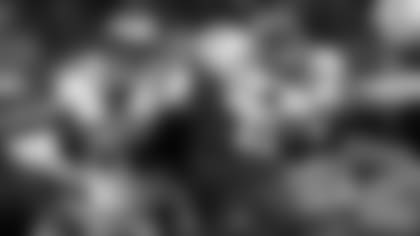
Gerald McCoy might lead the division's top DT group in 2014 but he'll still have to battle through the Saints' top guard combination
3. New Orleans Saints: Offensive Guard
When you think of the Saints' biggest strengths, you almost certainly start with Drew Brees, Jimmy Graham and Cameron Jordan. It might take you awhile to get to offensive guard, but that's unquestionably the answer for New Orleans in this exercise. Remember, we're looking for the position at which a team most significantly outshines the three other teams in the NFC South. There may not be a bigger depth chart disparity in the entire division than the one between the guard duo in the Bayou and everywhere else.
When Carl Nicks left for the Buccaneers in the spring of 2012, the Saints acted quickly to sign former Baltimore Raven Ben Grubbs as their new left guard. He stepped right in next to Jahri Evans and gave the Saints one of the best starting combinations in the entire league. New Orleans was the only team to put both of its guards in the Pro Bowl last year. According to the guard rankings over at Pro Football Focus, Grubbs was 11th-best at the position last year while Evans came in at #17. That made the Saints one of only two teams, along with the Packers, to have both of its guards in the top 20.
In Tampa and Charlotte, it's not yet clear which two players will be starting at the guard spots, which is all the analysis necessary to point out the gap between those teams and the Saints. Atlanta is more set, having signed former Chief Jon Asamoah on the first day of free agency to pair with Justin Blalock. Asamoah might not be in Evans' or Grubbs' category, but he should bring stability and competence to a line that tried a lot of different combinations last year.
Other positions considered: Actually, the Saints look like they are among the best at a lot of spots on the depth chart, just not be as wide of a margin as they are at guard. Jimmy Graham is the league's best pass-catching tight end, but Greg Olsen is no slouch in Carolina and the Bucs might end up with the deepest group at that position. Jairus Byrd and Kenny Vaccaro have a chance to be one of the league's best safety tandems, but hopefully the Bucs stay close at that position, especially with their added depth from the offseason (Mark Barron, Dashon Goldson, Major Wright, Keith Tandy). We've also already mentioned the Saints when it comes to linebacker, wide receiver and, of course, quarterback.
4. Tampa Bay Buccaneers: Defensive Tackle
As I said at the top, of the four teams it was hardest to find a definitive answer for the Buccaneers. I've put my chips on defensive tackle, but the gap between the Bucs and, say, the Panthers at that position doesn't look as large as what the Saints have over their opponents at guard.
It helps that you start out with the best player in the game at that position. I have no doubt that some would raise an argument for Ndamukong Suh or Geno Atkins or Jurell Casey or Haloti Ngata, but while McCoy is riding first-team All-Pro honors and the top spot among all DTs in the NFL Top 100 on NFL Network, I'm going to take that opportunity to call him number one. Moreover, he probably hasn't peaked yet, meaning multiple double-digit sack seasons are a very real possibility. Star Lotulelei looks like he might live up to his first name in Carolina, but he's not yet in McCoy's category.
The Bucs added to that strength by nabbing Seattle's Clinton McDonald on the first day of free agency in March. McDonald racked up 5.5 sacks while serving as a reserve in a D-Line rotation last year; make him a starter and put him next to McCoy and those numbers could go up. In addition, the Bucs have some depth at the position, starting with second-year player Akeem Spence, who started all season as a rookie in 2013.
The Panthers hit on both Lotulelei and Short in the 2013 draft and appear to be set on the interior line for years to come. They've also got some experienced depth in Colin Cole and Dwan Edwards. If the Bucs have a divisional edge at this position, they're going to have to work hard to keep it. New Orleans, with their 3-4 approach, has only three players on the roster they list as nose tackles, the most experienced of which is Brodrick Bunkley. The Falcons made a big effort to get more stout on the defensive line this offseason after getting pushed around up front last year, with Paul Soliai the main acquisition. Corey Peters and Jonathan Babineaux are solid veterans but certainly not in McCoy's class. Peria Jerry hasn't really panned out after his first-round selection in 2009, with a total of 5.5 sacks in five years.
Other positions considered: Well, as I mentioned before, the Bucs are trying to insert themselves into the quarterback and wide receiver conversations, but there is still too much to prove at those spots. On paper, the Bucs put together a potentially dominant safety tandem with Barron and Goldson, but the results weren't as good as expected last year. The emergence of a sidekick for Lavonte David would put the Bucs solidly in the linebacker discussion, and the team's most underrated position might be offensive tackle. I seriously considered cornerback, since that's a position of some concern in Atlanta and Carolina, but I don't think it's currently fair to say the Bucs are clearly ahead of the Saints. The Bucs have Pro Bowler Alterraun Verner now, but the Saints counter with a very effective Keenan Lewis. You could equate the Bucs' Mike Jenkins with the Saints' Patrick Robinson, so the competition might come down to whether Tampa Bay's (2013) second-round pick, Johnthan Banks, proves to be a stronger player than New Orleans' (2014) second-round pick, Stanley Jean-Baptiste. And, finally, the Bucs appear to be as deep as almost any team in the league at running back; if at least two of Mike James, Bobby Rainey and Charles Sims turn into strong, long-term contributors, the Bucs could be ready to take the NFC South mantle at that position.









